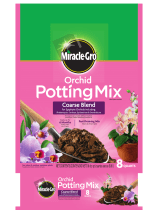Hanna Instruments HI3895 Le manuel du propriétaire
- Taper
- Le manuel du propriétaire

1
HI3895
Quick Soiltest
www.hannainst.com

2

3
ENGLISH ............................................................. 4
ITALIAN ............................................................ 11
SPANISH........................................................... 18
FRENCH ............................................................ 25
DEUTSCH .......................................................... 33
TABLES ............................................................. 40
Table of contents

4
Hanna Instruments Quick Soiltest for happy plants:
Hanna Instruments Quick Soiltest provides you with an economical way to rapidly test
the pH as well as the three basic elements needed for a healthier plant: nitrogen (N),
phosphorus (P) and potassium (K).
pH. Soil can be acid, neutral, or alkaline. Each plant has a range of pH in which it thrives
and most plants prefer conditions near the neutral mark (pH 5.5-7.5). There are however
plants that prefer acid or alkaline environments. The solubility of the nutrients, that is the
ability of the plants to absorb them, depends largely on their pH value. The soil micro-
biological activity is also pH dependent. Most bacteria, specially those putting nutrients at
the plants’ disposition, prefer moderately acid or slightly alkaline conditions. The pH level
hence influences the fertility of the soil.
Nitrogen (N). Nitrogen is an indispensable element for the growth of vegetation and is a
key factor in fertilization. A correct quantity of Nitrogen allows a healthy growth of the entire
structure and in particular creates a thriving and greener plant. An excess of Nitrogen on the
other hand, weakens the plant’s resistance creating an unbalanced relationship between
the green parts and the stems and trunk.
Phosphorus (P). Phosphorus contributes to the formation of buds, roots and blooming as
well as lignification. A lack of phosphorus results in a stifling of plant.
Potassium (K). Potassium plays an important role in how much water is absorbed by the
roots and the regulation of cellular activity. In addition, Potassium makes plants more resistant
to disease and yields a positive effect on the color and fragrance in flowers.

5
FRUIT & VEGETABLE - Testing the nitrogen and phosphorus level in
your soil is important, especially before seeding and replanting. While root
vegetables need phosphorus, leafy plants require more Nitrogen. Potassium,
on the other hand, helps increase the quality of the crop. With the HANNA
Quick Soiltest, you keep these three important elements under control.
FLOWERS & SHRUBS - The right quantity of potassium is the key factor
in ensuring beautiful and fragrant flowers. The other elements play an
important role too in achieving rapid and harmonious growth.
LAWNS - A lush lawn is the result of care and attention. In addition to
tilling and irrigation, the pH and nitrogen levels need regular checks. So,
what better than the HANNA Quick Soiltest in the quest for thicker and
greener lawns.
FRUIT & DECORATIVE TREES - Trees are the most appealing feature of
our gardens. Nitrogen and phosphorus help in speeding up the growth of
young plants, encouraging abundance of foliage and strengthening the trunk
and the roots. Potassium, on the other hand keeps, the plants in tip top
condition by protecting them from diseases.

6
BONSAI & HOUSEPLANTS - Every time a houseplant, but in particular
a bonsai is potted, the choice of soil mixture is of prime importance.
Having prepared the mixture, the HANNA Quick Soiltest will in a matter
of minutes test the level of pH and other elements ensuring a livelier
plant.
WHEN TO TEST YOUR SOIL
Your soil should be tested prior to seeding, planting and fertilizing as well as when other
soil, manure or compost has been added and not only when the plants do not seem to be
in a tip top condition (yellow leaves or stunted growth).
SAMPLING
1) Extracting Soil Sample
• With a large field, take 1 or 2 samples per 1000 m
2
(0.25 acre) of homogeneous
areas.
• Even for smaller areas, 2 samples are recommended (the more the samples,
the better the end-results).
• If you have a small garden or plot, 1 sample is sufficient.
2) Avoid extracting samples from soil presenting obvious anomalies.
3) Sample quantity: take the same quantity of soil for each sample. For example, use bags
with similar dimensions (1 bag per sample).

7
4) Depth of extraction:
• General: dig and discard the 5 cm (2") of topsoil
• For lawns: take the sample at a depth of 5 to 15 cm (from 2" to 6").
• For other plants (flowers, vegetables, shrubs): from 20 to 40 cm of depth (8" to 16")
• For trees: Samples from 20 to 60 cm of depth (8" to 24'’).
5) Mix all the samples together to obtain a homogeneous mixture of soil.
TEST PROCEDURE
Reading the Color-Card
The pH, phosphorus (P
2
O
5
), and nitrogen (NO
3
) tests use colorimetric methods of testing.
The color developed corresponds to the soil fertility. To figure out the fertility, the color which
appears must then be compared against the Color-card.
To match the color, hold the tube containing the test solution approximately 2 cm away
from the color-card. Stand with a light source behind the card and match the test tube color
to that of the Color-card to read: Trace, Low, Medium or High. If the color of the test tube
falls between two standard colors, e.g. between Medium and High, the test result is then
Medium-High. Eight different readings are possible, Trace, Trace-Low, Low, Low-Medium,
Medium, Medium-High, High, and very-High.
The potassium (K
2
O) test utilizes a turbidimetric method. To obtain the test result, rest
the tube against the Color-card over the reading area. Stand with the light source
behind your back. Start at Trace, look through the tube, and go to Low, Medium or

8
High until you see the white line in the middle of the reading area of the Color-card. The
test result is obtained in Trace, Low, Medium or High.
Performing the test
pH test. Add half a teaspoon of soil to the test tube and fill it to the lower graduation mark
with water (2.5 mL): use the graduated card for the measure. For best results, use bottled
or distilled water. Add the content of one packet of HI3895pH-0 pH reagent, replace the
cap and shake gently for 30 seconds. Allow the tube to stand for 5 minutes. Match the
color with the pH color-card and read the pH value.
Nitrogen (N) - Phosphorus (P) - Potassium (K):
General Extraction Procedure [for the P, N, and K tests]
Add the following to a clean can or a coffee jar:
Field soil: 1.5 cup of soil and 8 cups of water
Garden soil: 1 cup of soil and 8 cups of water
Greenhouse soil: 1 cup of soil and 16 cups of water
For best results, use bottled or distilled water. Stir or shake gently for at least one minute
and make sure that all the soil is moistened. Allow to stand until the soil settles (from 30
minutes to 24 hours depending on the soil texture). The clearer the extract becomes, the
better the results, however, a little cloudiness will not affect the accuracy of the test.

9
Nitrogen (NO
3
) test. Use the pipette to transfer 2.5 mL of the clear general soil extract
(above) to a clean test tube [*]. Add the content of one packet of HI3895N-0 Nitrogen
reagent to the tube, replace the cap and shake well for 30 seconds to dissolve the reagent.
Allow the tube to stand for 30 seconds, match the pink color with the Nitrogen color-card.
Phosphorus (P
2
O
5
) test. Use the pipette to transfer 2.5 mL of the clear general soil extract
(see above) to a clean test tube [*]. Add the contents of one packet of HI3895P-0
Phosphorus reagent to the tube, replace the cap and shake well for 30 seconds to dissolve
the reagent. Match the blue color against the Phosphorus color-card for the P concentration.
Potassium (K
2
O) test. Use the pipette to add 0.5 mL of the clear general soil extract (above)
to a clean test tube [*]. Fill the tube to the lower graduation mark (2.5 mL) with water. Add
the content of one packet of HI3895K-0 Potassium reagent to the tube, replace the cap and
shake well for 30 seconds to dissolve the reagent. A blue color develops. Read the TURBIDITY
formed on the K
2
O reading-card as explained in the "Test procedure", and note the K
2
O.
[*]: Don’t transfer any soil. To avoid agitation of the soil, squeeze the bulb of the pipette
before inserting the pipette into the soil extract solution.

10
HEALTH & SAFETY
The chemicals contained in this test kit may be hazardous if improperly handled. Read carefully
Health & Safety Data Sheets before performing the tests.
Health and safety data sheets are available on line: www.hannainst.com
CONTENTS
Each kit is supplied with:
• 40 powder packets (10 each for pH, N, P and K);
• 1 plastic pipette (1 mL);
• 4 test tubes;
• 4 Color Cards;
• 1 Graduated Card.

11
Hanna Instruments Quick soiltest per avere piante felici
Hanna Instruments Quick Soiltest ti permette, in modo rapido ed economico di controllare
il pH ed i tre elementi di base per le piante: azoto (N), fosforo (P) e potassio (K).
pH. Un suolo può essere acido, neutro o basico. Ogni coltivazione ha degli intervalli di pH
entro i quali riesce a svolgere meglio le proprie funzioni vitali. La maggior parte delle piante
preferisce condizioni vicine alla neutralità (pH 5.5-7.5), anche se ce ne sono che prediligono
ambienti acidi o alcalini. La solubilità degli elementi nutritivi, e quindi la possibilità che le
piante possano assorbirli, dipende notevolmente dal pH. Anche l’attività microbiologica del
suolo viene influenzata dal pH. L'ambiente ideale per la maggior parte dei batteri, tra cui
quelli che forniscono le sostanze nutritive alle piante, è caratterizzato da un pH vicino alla
neutralità (6.0-7.5). Il valore di pH, perciò, influenza la fertilità del terreno.
Azoto (N). È un elemento indispensabile per lo sviluppo vegetativo ed ha un ruolo primario
nei piani di fertilizzazione. Una adeguata presenza di azoto permette un accrescimento di
tutta la struttura vegetativa ed, in particolare, uno sviluppo rigoglioso della parte verde
della pianta; tuttavia, un eccesso di azoto comporta una minore resistenza della pianta e
un rapporto non equilibrato tra parte verde e parte lignificata.
Fosforo (P). Contribuisce alla lignificazione, alla differenziazione delle gemme, alla
formazione di radici e fiori. Una carenza di fosforo si manifesta con nanismo.
Potassio (K). Ha una importante funzione regolatrice per quanto riguarda l’assorbimento
di acqua dalle radici e per il turgore cellulare. Inoltre, rende la pianta maggiormente

12
resistente alle malattie e svolge un’azione positiva nei confronti del colore e del profumo
dei fiori.
ORTO - Controllare il livello di azoto e fosforo nel tuo terreno è
importante, specialmente prima della semina e dei trapianti. Mentre
l’apparato radicale richiede fosforo, la parte aerea ha bisogno di azoto
per svilupparsi. Il potassio contribuisce ad aumentare la qualità dei
prodotti. Con HANNA Quick Soiltest, puoi tenere sotto controllo questi
tre importanti elementi.
FIORI E GIARDINO - La giusta quantità di potassio è l’elemento chiave
per avere fiori belli e profumati. Gli altri elementi giocano un ruolo
importante per una crescita armoniosa e veloce.
PRATO - Un bel prato è il risultato di attente cure. In aggiunta alle
lavorazioni del terreno e alle irrigazioni, bisogna controllare in modo
regolare il pH e la quantità di azoto. Potrai farlo con HANNA Quick
Soiltest, per un prato più verde e folto.
PIANTE ARBOREE E DA FRUTTO - Gli alberi sono l’elemento domi-
nante del nostro giardino. Azoto e fosforo accelerano la crescita delle
piante giovani e mantengono la chioma rigogliosa ed il tronco robusto;
il potassio favorisce la fioritura e la salute della pianta proteggendola
dallo stress e dalle malattie.

13
BONSAI E PIANTE IN VASO - Ogni volta che una pianta, ed in
particolare un bonsai, deve essere rinvasata, la scelta della miscela di
terriccio che impieghiamo è di primaria importanza. Dopo aver preparato
la miscela, HANNA Quick Soiltest ti permette di controllare che il pH e
la concentrazione degli elementi più importanti (N, P e K) siano quelli
desiderati.
QUANDO FARE LE ANALISI
Il tuo terreno dovrebbe essere controllato prima di ogni semina o trapianto, prima di
fertilizzare, in caso di modificazioni del terreno (es. aggiunta di terreno di riporto, aggiunta
di ammendanti); in caso di anomalie dello stato sanitario delle piante (ingiallimento delle
foglie, crescita stentata).
CAMPIONAMENTO
1) Prelievo dei campioni di terreno
• In caso di un terreno di ampie dimensioni, è sufficiente prelevare 1 o 2 campioni
ogni 1000 m
2
(che si presentino omogenei)
• Per appezzamenti di dimensioni ridotte, è, comunque, consigliabile prendere almeno
due campioni (maggiore è il numero di campioni, maggiormente l’analisi darà un
valore medio rappresentativo dell’appezzamento)
• Se l’appezzamento ha dimensioni assai ridotte (es. piccolo orto) 1 solo campionamento
è sufficiente

14
2) Scartare porzioni di terreno che presentino grandi anomalie
3) Quantità di campione:
deve essere la stessa per ogni campione; per esempio, riempiendo un sacchetto delle stesse
dimensioni (un sacchetto per ogni campione)
4) Profondità da cui prelevare il campione:
• Scartare i primi 5 cm di terreno
• Prato tra 5 e 15 cm
• Altre piante (ortive, fiori, arbustive) tra 20 e 40 cm
• Piante arboree tra 20 e 60 cm
5) miscelare i campioni prelevati, ottenendo un miscuglio omogeneo di terreno, dal quale
prendere il quantitativo per l’analisi
METODO DI ANALISI
Lettura dei cartoncini colorati comparatori
I tests per il pH, il fosforo (P
2
O
5
) e l’azoto (NO
3
) usano un metodo colorimetrico. Il colore
sviluppato corrisponde alla fertilità del suolo. Per misurare la fertilità, il colore che appare
deve essere confrontato con quelli presenti sul cartoncino comparatore.
Per confrontare il colore, tenere la provetta contenente la soluzione da testare a circa 2 cm
di distanza dal cartoncino comparatore. Tenere la sorgente luminosa dietro al cartoncino
comparatore e misurare, confrontando il colore della soluzione nella provetta con quello
del cartoncino: Trace (scarso), Low (poco), Medium (medio) o High (alto) Se il colore della

15
provetta cade tra due colori, per esempio tra Medium e High, il risultato del test è
Medium-High. In questo modo, sono possibili otto differenti letture: Trace, Trace-Low, Low,
Low-Medium, Medium, Medium-High, High, e very-High.
Il test del potassio (K
2
O) utilizza un metodo turbidimetrico. Per leggere il risultato del test,
tenere la provetta appoggiata all’area di lettura del cartoncino comparatore, con la sorgente
luminosa dietro alle spalle. Spostare la provetta da Trace verso Low, Medium o High, fino
a che sarà possibile intravedere la linea bianca posta nel mezzo dell’area di lettura del
cartoncino comparatore. Il risultato del test sarà dato da: Trace, Low, Medium o High.
Preparazione della soluzione
pH test. Aggiungere mezzo cucchiaino da the di terreno nella provetta e riempirla con acqua
fino al più basso segno di gradazione (2.5 mL): usare il cartoncino graduato per la misura.
Per migliori risultati, usare acqua imbottigliata o distillata. Aggiungere il contenuto di una
bustina di reagente HI3895pH-0, richiudere la provetta e agitare piano per 30 secondi.
Lasciare la provetta in posizione verticale per 5 minuti. Confrontare il colore della soluzione
con quello del cartoncino comparatore per il pH e leggere il valore.
Azoto (N) - Fosforo (P) - Potassio (K)
Procedura generale di estrazione (per i tests P, N, e K)
Aggiungere i seguenti quantitativi di terreno e acqua in un recipiente pulito (usando una
tazza da caffè):

16
Terreno di campo: 1.5 tazze di terreno e 8 tazze di acqua
Terreno di Giardino: 1 tazza di terreno e 8 tazze di acqua
Terreno di serra: 1 tazza di terreno e 16 tazze di acqua
Per migliori risultati, usare acqua imbottigliata o distillata. Mescolare e agitare per almeno
un minuto, in modo che il terreno sia completamente disciolto. Lasciare sedimentare il terreno
disciolto (da 30 minuti a 24 ore, in base alla tessitura). Meno torbido risulta l’estratto,
migliore sarà per eseguire il test, comunque, una leggera torbidità non influenza il risultato
del test.
Azoto (NO
3
) test. Usare la pipetta per trasferire 2.5 mL di estratto di terreno, senza
impurità (vedi sopra) in una provetta pulita [*]. Aggiungere il contenuto di una bustina di
reagente HI3895N-0, richiudere la provetta e agitare bene per 30 secondi per disciogliere
il reagente. Lasciare la provetta in posizione verticale per 30 secondi. Confrontare il colore
(rosa) della soluzione con quello del cartoncino comparatore N per l’azoto.
Fosforo (P
2
O
5
) test. Usare la pipetta per trasferire 2.5 mL di estratto di terreno, senza
impurità (vedi sopra) in una provetta pulita [*]. Aggiungere il contenuto di una bustina di
reagente HI3895P-0, richiudere la provetta e agitare bene per 30 secondi per disciogliere
il reagente. Confrontare il colore (blu) della soluzione con quello del cartoncino comparatore
P per il fosforo.
Potassio (K
2
O) test. Usare la pipetta per trasferire 0.5 mL di estratto di terreno,senza
impurità (vedi sopra) in una provetta pulita [*]. Aggiungere acqua fino al più basso

17
segno di gradazione (2.5 mL) della provetta.
Aggiungere il contenuto di una bustina di reagente HI3895K-0, richiudere la provetta e
agitare bene per 30 secondi per disciogliere il reagente. Si sviluppa un colore blu. Leggi la
TURBIDITÀ formata sulla scheda di lettura K
2
O come spiegato nella "Procedura di test",
e nota il K
2
O.
[*]: Non trasferire particelle di terreno. Per evitare l’agitazione del terreno, schiacciare il bulbo della
pipetta prima di inserirla nell’estratto di terreno
AVVERTENZE PER L’USO
I reagenti contenuti in questo test kit possono risultare pericolosi se impropriamente utilizzati.
Leggere attentamente le schede di sicurezza prima dell'uso.
Le schede di sicurezza sono disponibili on line: www.hannainst.com
CONTENUTO
• 40 bustine di reagente (10 per ogni test : pH, N, P e K);
• 1 pipetta (1mL);
• 4 provette;
• 4 cartoncini comparatori;
• 1 cartoncino graduato.

18
Hanna Instruments Quick Soiltest para conseguir plantas lozanas:
El test de suelos rápido, de Hanna Instruments, proporciona al usuario una manera
económica de comprobar rápidamente el pH así como los tres elementos básicos necesarios
para una planta más sana: nitrógeno (N), fósforo (P) y potasio (K).
pH. El suelo puede ser ácido, neutro o alcalino. Cada planta tiene un rango de pH en el
que crece muy bien y la mayor parte de las plantas prefieren condiciones próximas a la
marca neutra (pH 5,5-7,5). No obstante, existen plantas que prefieren entornos ácidos o
alcalinos. La solubilidad de los nutrientes, esto es, la capacidad de las plantas de absorberlos,
depende sobremanera de su pH. La actividad microbiológica del suelo también depende
del pH. La mayoría de las bacterias, especialmente las que ponen nutrientes a disposición
de las plantas, prefieren condiciones moderadamente ácidas o ligeramente alcalinas. Por
lo tanto, el nivel de pH influye en la fertilidad del suelo.
Nitrógeno (N). El nitrógeno es un elemento imprescindible para el crecimiento de la
vegetación y constituye un factor clave en la fertilización. Una cantidad correcta de nitrógeno
permite un crecimiento sano de toda la estructura y, en particular, crea una planta floreciente
y más verde. Por otra parte, un exceso de nitrógeno debilita la resistencia de las plantas y
crea una relación desequilibrada entre las partes verdes y los tallos y el tronco.
Fósforo (P). El fósforo contribuye a la formación de brotes, raíces y a la floración, así como
a la lignificación. La falta de fósforo hace que la planta se ahogue.

19
Potasio (K). El potasio desempeña un papel importante en la cantidad de agua que es
absorbida por las raíces y en la regulación de la actividad celular. Además, el potasio hace
las plantas más resistentes a las enfermedades y produce un efecto positivo en el color y
la fragancia de las flores.
JARDINES DE FRUTAS Y HORTALIZAS - Comprobar el nivel de nitrógeno
y fósforo del suelo es importante, especialmente antes de sembrar y replan-
tar. Mientras los vegetales de raíces necesitan fósforo, las plantas de hoja
requieren más nitrógeno. El potasio, por otra parte, ayuda a aumentar la
calidad del cultivo. Con HANNA Quick Soiltest, el usuario mantiene estos
tres importantes elementos bajo control.
FLORES Y ARBUSTOS - La cantidad justa de potasio es el factor clave para
asegurar la obtención de flores hermosas y olorosas. Los otros elementos
también juegan un papel importante en la consecución de un crecimiento
rápido y armonioso.
CÉSPEDES - Un césped lozano y exuberante es el resultado de atención
y cuidado. Además del cultivo y el riego, es necesario comprobar perió-
dicamente los niveles de pH y nitrógeno. Por lo tanto, qué mejor que el
Test de Suelos Rápido de HANNA para conseguir céspedes más espesos
y más verdes.

20
ÁRBOLES FRUTALES Y ORNAMENTALES - Los árboles son la car-
acterística más atrayente de nuestros jardines. El nitrógeno y el fósforo
ayudan a acelerar el crecimiento de las plantas jóvenes, estimulando la
abundancia de hojas y fortaleciendo el tronco y las raíces. El potasio, por
otra parte, mantiene las plantas en excelentes condiciones, protegiéndolas
de las enfermedades.
BONSAIS Y PLANTAS DE INTERIOR - Cada vez que una planta
de interior –pero especialmente un bonsai– se planta en maceta, la
selección de la mezcla de tierra es de primerísima importancia. Una vez
preparada la mezcla, el test de suelos rápido de HANNA comprobará,
en cuestión de minutos, el nivel de pH y otros elementos que aseguran
la obtención de una planta más viva.
CUÁNDO SE HA DE COMPROBAR EL SUELO
El suelo se debe comprobar antes de la siembra, la plantación y la fertilización, así como
cuando se ha añadido otra tierra, abono o compost, y no sólo cuando las plantas no parecen
estar en excelentes condiciones (hojas amarillas o crecimiento achaparrado)
TOMA DE MUESTRAS
1) Extracción de una muestra de suelo
• En el caso de un campo grande, tomar 1 o 2 muestras por 1000 m
2
de áreas
homogéneas.
La page est en cours de chargement...
La page est en cours de chargement...
La page est en cours de chargement...
La page est en cours de chargement...
La page est en cours de chargement...
La page est en cours de chargement...
La page est en cours de chargement...
La page est en cours de chargement...
La page est en cours de chargement...
La page est en cours de chargement...
La page est en cours de chargement...
La page est en cours de chargement...
La page est en cours de chargement...
La page est en cours de chargement...
La page est en cours de chargement...
La page est en cours de chargement...
La page est en cours de chargement...
La page est en cours de chargement...
La page est en cours de chargement...
La page est en cours de chargement...
La page est en cours de chargement...
La page est en cours de chargement...
La page est en cours de chargement...
La page est en cours de chargement...
La page est en cours de chargement...
La page est en cours de chargement...
La page est en cours de chargement...
La page est en cours de chargement...
-
 1
1
-
 2
2
-
 3
3
-
 4
4
-
 5
5
-
 6
6
-
 7
7
-
 8
8
-
 9
9
-
 10
10
-
 11
11
-
 12
12
-
 13
13
-
 14
14
-
 15
15
-
 16
16
-
 17
17
-
 18
18
-
 19
19
-
 20
20
-
 21
21
-
 22
22
-
 23
23
-
 24
24
-
 25
25
-
 26
26
-
 27
27
-
 28
28
-
 29
29
-
 30
30
-
 31
31
-
 32
32
-
 33
33
-
 34
34
-
 35
35
-
 36
36
-
 37
37
-
 38
38
-
 39
39
-
 40
40
-
 41
41
-
 42
42
-
 43
43
-
 44
44
-
 45
45
-
 46
46
-
 47
47
-
 48
48
Hanna Instruments HI3895 Le manuel du propriétaire
- Taper
- Le manuel du propriétaire
dans d''autres langues
Autres documents
-
 Knock Out Rose 71353 Manuel utilisateur
Knock Out Rose 71353 Manuel utilisateur
-
DRIFT 62432 Manuel utilisateur
-
DRIFT 62412 Manuel utilisateur
-
 Knock Out Rose 71113 Mode d'emploi
Knock Out Rose 71113 Mode d'emploi
-
 Knock Out Rose 7139Q Mode d'emploi
Knock Out Rose 7139Q Mode d'emploi
-
DRIFT 62421 Mode d'emploi
-
 Knock Out Rose 71093 Manuel utilisateur
Knock Out Rose 71093 Manuel utilisateur
-
Sera iron-Test (Fe) Information For Use
-
 Miracle-Gro 74778300 Mode d'emploi
Miracle-Gro 74778300 Mode d'emploi
-
Lego 10329 Icons Building Instructions




















































